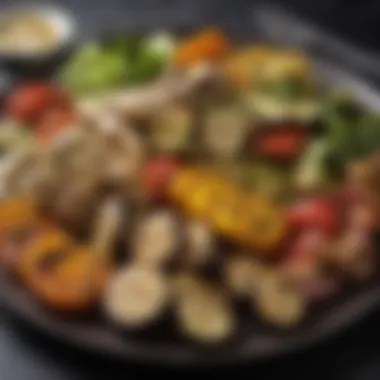Exploring Delicious Low Carb Main Dishes


Intro
Low carb meals have gained popularity in recent years due to their potential health benefits, including weight management and improved metabolic health. This exploration of low carb main dishes aims to guide culinary enthusiasts through the diverse world of flavors and techniques that can be employed while adhering to a low carbohydrate lifestyle.
In this article, we will delve into a variety of recipes that satisfy not only dietary needs but also the demands of taste and preparation. Each recipe will be evaluated for its historical context, essential ingredients, and the cooking methods that bring them to life. This will equip both novice cooks and seasoned chefs with the tools needed to create appealing and satisfying meals that celebrate the low carb ethos without sacrificing quality.
As you navigate through this guide, you will find key insights into ingredient selection and preparation tips that will enhance your culinary skills. The aim is to reflect the diverse cultural landscapes that these low carb dishes represent, showcasing their significance and evolution throughout culinary history.
We hope to inspire creativity and confidence in the kitchen, allowing readers to experiment and develop their unique low carb dishes.
Prelude to Low Carb Cooking
In recent years, the low carb cooking trend has gained significant attention in the realms of nutrition and dietary practices. This section aims to delve into the meaning and importance of low carb diets, contextualizing them within the broader culinary landscape. Kitchens worldwide are adapting to this shift, leading to innovative recipes and cooking methods that highlight the potential of low carbohydrate meals. Understanding low carb cooking is pivotal not only for personal health but also for evolving cooking habits that are increasingly aware of nutritional quality.
Understanding Low Carb Diets
Low carb diets primarily focus on limiting carbohydrate intake while emphasizing proteins and fats as the main energy sources. This approach has evolved from the simple idea of reducing sugar and processed grains to a more diverse dietary framework. Common examples of these diets include the ketogenic and Atkins diets, both of which advocate a significant reduction in carbohydrate consumption.
The underlying concept of low carb diets is rooted in the body's reaction to carbohydrate intake. When carbs are limited, the body shifts its primary source of fuel from glucose to stored fat, a process known as ketosis. This metabolic change not only supports weight loss; it may also improve overall health markers such as blood sugar levels, energy levels and mental clarity. It is very important to consider individual dietary needs and medical advice before implementing a low carb approach.
Benefits of Low Carb Meals
The benefits of low carb meals extend beyond weight management. Many people find that incorporating low carb dishes into their diet fosters a deeper understanding of food choices and nutrition.
Some key advantages include:
- Weight Loss: Low carb diets can accelerate weight loss by increasing feelings of fullness and reducing hunger. This often results in lower calorie intake overall.
- Improved Insulin Sensitivity: For those with insulin resistance or types of diabetes, reducing carb intake can yield significant health benefits, stabilizing blood sugar levels.
- Heart Health: Lower carb diets can positively influence various markers of heart health, including triglycerides and HDL cholesterol.
- Increased Mental Clarity: Many individuals report enhanced focus and clarity when following a low carb diet, likely due to stable blood sugar levels.
As these benefits become more widely acknowledged, low carb cooking continues to evolve, leading to a plethora of delightful and healthy recipes that cater to diverse palates and dietary needs. Embracing low carb cooking is not just an individual journey; it forms part of a larger conversation around healthy eating practices.
"A low carb diet provides a unique opportunity to explore the breadth of culinary options available while promoting personal health benefits."
This shift towards low carb cooking is not just a trend but an evolving culinary philosophy that invites creative and health-conscious meal preparations.
Key Ingredients for Low Carb Main Dishes
In the realm of low carb cooking, understanding the key ingredients is essential. These ingredients not only define the meals but also enhance the nutritional value while ensuring flavorful outcomes. The focus will be on three core elements: proteins, low carb vegetables, and healthy fats. Each plays a distinct role in meal preparation and contributes to the overall success of the dishes.
Proteins: The Core Element
Proteins are fundamental in any low carb diet. They provide the necessary building blocks for body tissues and are critical for muscle maintenance and repair. Choosing the right protein sources can influence not just taste but also health outcomes.
Lean meats such as chicken, turkey, and pork offer low fat options packed with nutrients. Fish, particularly fatty varieties like salmon or mackerel, provide both protein and omega-3 fatty acids, promoting heart health. Additionally, plant-based proteins like tofu and tempeh are suitable for those preferring a vegetarian approach.
Here are some benefits of including protein in your low carb meals:
- Supports muscle growth and recovery.
- Enhances satiety, reducing overeating.
- Aids in maintaining stable blood sugar levels, which is vital for energy management.
Ultimately, a well-rounded low carb meal should aim for a substantial protein portion to ensure satisfaction and nutritional balance.
Low Carb Vegetables
In any low carb main dish, vegetables that are low in carbohydrates must be highlighted. These vegetables are typically high in fiber, vitamins, and minerals while remaining low in calories, making them ideal for dieters. Leafy greens like spinach, kale, and romaine are necessary components. Cruciferous vegetables such as broccoli, cauliflower, and Brussels sprouts are also excellent choices.
Including a variety of low carb vegetables enhances the flavor profile and adds color to the plate. Nutritionally, these vegetables contribute to:
- Increased fiber intake, supporting digestive health.
- Antioxidants that protect against chronic diseases.
- Essential nutrients that complement protein sources.


Incorporating these ingredients helps to create visually appealing and nourishing dishes.
Healthy Fats: Importance and Sources
Healthy fats are crucial in a low carb diet. They provide energy, aid in the absorption of vitamins, and can promote heart health when consumed in moderation. Unlike unhealthy fats, such as trans fats found in many processed foods, healthy fats include monounsaturated and polyunsaturated fats.
Sources of healthy fats include:
- Avocados, which are not only rich in fats but also enhance taste and texture.
- Olive oil, ideal for cooking and dressings, known for its heart-healthy properties.
- Nuts and seeds, providing both crunch and nutritional benefits.
Incorporating fats in a balanced way is vital for overall well-being. It can help keep you feeling full and satisfied, reducing cravings for sugary snacks. The right fats can elevate a dish while complementing the flavors of proteins and carbohydrates alike.
"Low carb cooking is not just about restriction but about choosing the right attributes for a flavorful and nutritious meal."
Through understanding and selecting these key ingredients, one can craft low carb main dishes that are nutritious, satisfying, and varied.
Exploring Various Types of Low Carb Main Dishes
Understanding the variety of low carb main dishes is essential for anyone interested in this dietary approach. These dishes offer not just flavor but also significant benefits for those seeking to reduce carbohydrate intake without sacrificing nutrition or taste. Exploring diverse recipes allows individuals to enjoy a wide range of flavors and textures while adhering to their dietary goals. It also uncovers how various cultural influences can enrich these dishes, making low carb cooking more appealing and accessible.
Meat-Based Low Carb Dishes
Grilled Chicken and Vegetable Skewers
Grilled chicken and vegetable skewers are a staple in the realm of low carb meals. They represent a healthy source of lean protein paired with low carb veggies, making them an ideal main dish. The key characteristic of this dish lies in its versatility; it can be customized with different marinades and vegetables to suit personal tastes.
This dish is popular for a few reasons. First, it is straightforward to prepare and cooks quickly, making it suitable for busy weeknights. Furthermore, grilling imparts a unique smokiness that enhances the flavor without the need for heavy sauces.
A unique feature of grilled chicken and vegetable skewers is their presentation. They look appealing on the plate, inviting diners to indulge in a colorful array of ingredients. On the downside, skewer preparation may require some additional effort in chopping veggies and skewering them properly, but the outcome is often worth it.
Beef Stir-Fry with Low Carb Vegetables
Beef stir-fry with low carb vegetables represents an efficient way to combine protein and fiber-rich vegetables into one satisfying dish. This preparation highlights quick cooking techniques that preserve the texture and nutrients of the ingredients, which is especially beneficial in low carb diets focusing on whole foods.
The dish stands out for its full-bodied flavors that are easily adjustable based on personal preferences. The use of sauces, like soy sauce or a keto-friendly alternative, adds complexity while keeping carbs in check. It is a wonderful option for anyone wanting a meal that feels hearty yet aligns perfectly with a low carb lifestyle.
One unique aspect of this dish is how quickly it can be made. Beef stir-fry is often ready in under thirty minutes, making it efficient for both prepping and cooking. However, dining out options tend to be more restricted since many restaurant stir-fries may include hidden starches or sugars, thus, preparing it at home usually provides better control over the ingredients.
Seafood Options
Herb-Crusted Salmon
Herb-crusted salmon is a popular choice in the low carb cooking landscape. Salmon is an excellent source of omega-3 fatty acids, making it a health-conscious choice that is nutrient-dense. This dish captures the essence of low carb dining by providing a rich flavor profile while remaining low in carbohydrates.
The herb crust not only adds vibrant flavor but also makes the dish visually attractive when plated. Using fresh herbs can enhance aroma and taste, making it a delightful dining experience.
A unique feature of herb-crusted salmon is its adaptability; it works well with various herbs and spices, allowing for seasonal variations according to availability. However, one potential downside is that individuals unfamiliar with cooking fish may find it intimidating, but with practice, it becomes simpler.
Shrimp and Avocado Salad
Shrimp and avocado salad stands out as a refreshing dish that is both low in carbs and high in healthy fats. This combination is not only flavorful but also filling, making it a suitable option for a main dish or a side. The dish integrates seafood and plant elements seamlessly, providing a nutritional boost.
This salad is a popular choice because it requires minimal cooking skills. The shrimp can be quickly sautéed or grilled, and the avocado adds creaminess without depending on dressings full of sugar or unnecessary carbs.
The unique aspect of this dish is its cooling effect, often making it ideal for hot days or as a light dinner. The primary disadvantage might be its reliance on fresh ingredients, which can vary in quality based on seasonality, affecting overall taste.
Plant-Based Low Carb Dishes
Zucchini Noodles with Pesto


Zucchini noodles with pesto deliver a creative twist on traditional pasta, making it an appealing option for those seeking low carb alternatives. Zucchini, known for its low carbohydrate content, serves as an excellent base for various sauces, especially a rich, homemade pesto.
The key characteristic of this dish is its simplicity. It allows for a quick preparation time while still delivering fresh flavors from the herbs and vegetables used in pesto. This dish is also favorable due to its ability to pack in nutrients without the heavy carbohydrates typically found in traditional pasta.
A unique feature of zucchini noodles is their texture, which surprisingly mimics that of pasta when prepared correctly. Although some may find that the zucchini does not have the same consistency, it provides a refreshing contrast that many enjoy. The main disadvantage could be that it may not satisfy everyone who craves the traditional pasta experience.
Eggplant Parmesan
Eggplant Parmesan offers a hearty, cheesy dish that can cater to those on a low carb diet while still being indulgent. Eggplant’s natural texture allows it to absorb flavors well, providing a satisfying experience that mimics comfort foods.
The dish's appeal lies in its layering of flavors and textures through the combination of eggplant, marinara sauce, and cheese. It can serve as a filling main meal while remaining gluten-free and low in carbs.
A unique feature of Eggplant Parmesan is its baking method, allowing for less oil compared to frying, making it healthier. One downside could be the time it takes to prepare, as it often requires salting and waiting to draw moisture from the eggplant to achieve the best results. However, this effort can lead to a rewarding final dish.
Cultural Influences on Low Carb Cooking
Cultural influences play a significant role in shaping culinary practices, and low carb cooking is no exception. Various global cuisines offer unique perspectives on how to prepare meals with reduced carbohydrate content. This section delves into the ways different cultures incorporate low carb principles, demonstrating that flavor and variety are still attainable while adhering to dietary guidelines.
Understanding these cultural influences allows cooks to adapt traditional recipes, ensuring they remain relevant for those aiming to limit their carb intake without sacrificing the essence of the flavors they cherish. This exploration not only highlights the creative potential within low carb cooking but also encourages appreciation for diverse culinary traditions that can enhance one’s diet.
Italian Low Carb Dishes
In Italian cuisine, where pasta and bread typically dominate, there are innovative ways to enjoy low carb dishes without missing out on authentic flavors.
Low Carb Pizza with Cauliflower Crust
The low carb pizza with cauliflower crust offers a revolutionary alternative to traditional pizza bases. Instead of using high-carb dough, this recipe replaces it with a crust made primarily from cauliflower. The key characteristic of this dish lies in its ability to deliver the classic pizza experience while significantly lowering carbohydrate intake.
This option is popular among those following a low carb diet due to the versatility of toppings. One unique feature of the cauliflower crust is its ability to remain crunchy, providing a satisfying texture. However, one should note that it may require careful preparation to achieve the right consistency.
Zoodles with Tomato Sauce
Zoodles, or zucchini noodles, paired with tomato sauce represent another Italian-inspired dish that adapts well to low carb cooking. This meal effectively substitutes traditional pasta, making it suitable for a low carb diet. The main benefit of zoodles is their nutritional profile; they are low in calories and carbohydrates while high in vitamins and minerals.
The unique feature of this dish is how zucchini absorbs flavors from the sauce, making it a delightful choice when prepared correctly. While the texture might differ slightly from standard pasta, zoodles provide a fresh alternative that does not compromise taste.
Asian-Inspired Low Carb Meals
Asian cuisine contributes a plethora of options for low carb meals, utilizing a blend of spices, herbs, and sauces that enhance flavors.
Thai Curry with Broccoli
Thai curry with broccoli combines rich flavors with nutritious ingredients, making it a fitting entry in the realm of low carb meals. The essential aspect of this dish is the use of coconut milk and curry paste, which provide depth without relying heavily on carbohydrates. Broccoli, a nutrient-dense vegetable, serves as the main ingredient, boosting fiber intake alongside flavor.
This dish is notable for its simplicity and adaptability. One advantage is the ability to customize the spice level according to personal preferences. However, attention must be paid to portion sizes, especially if served with rice, which is higher in carbs.
Keto Sushi Rolls
Keto sushi rolls pave the way for enjoying sushi while maintaining low carb principles. This dish typically substitutes traditional rice with alternatives such as cauliflower rice or avocado. The key characteristic of keto sushi is its ability to offer the same satisfying experience of traditional sushi rolls minus the carbs.
A significant advantage of this dish is its versatility, allowing for an assortment of fillings according to taste. One must consider, however, that these rolls may not replicate the exact texture of conventional sushi, which can lead to a different dining experience.
Mexican Low Carb Recipes
Mexican cuisine is rich with flavors and can easily accommodate low carb principles using the right ingredients.
Stuffed Bell Peppers
Stuffed bell peppers present a colorful and nutritious option for those opting for low carb meals. The core element of this dish is the filling, which typically includes ground meats, cheese, and spices, all wrapped in a bell pepper vessel. These peppers deliver a satisfying presentation while being low in carbohydrates, making them a popular choice for health-conscious diners.


A unique feature of this recipe is its adaptability; you can modify the filling to suit various tastes while still keeping the carb count low. It can be a challenge to balance flavors and ensure the filling is moist, so care must be taken during preparation.
Taco Salad with Avocado Dressing
Taco salad with avocado dressing combines the familiar flavors of tacos in a low carb-friendly form. The salad replaces high-carb tortillas with fresh vegetables, topped with an avocado-based dressing that adds creaminess and richness. This meal is beneficial due to its nutrient density and the healthy fats provided by avocados.
The unique feature is the fresh and crunchy texture it provides, differentiating it from traditional taco presentations. However, one should be cautious of portion control with the dressing to keep overall carbs in check.
Overall, exploring cultural influences on low carb cooking shows a remarkable range of flavors and food combinations. By adapting traditional recipes, cooks can create satisfying dishes that respect both taste and nutritional guidance.
Tips for Crafting Delicious Low Carb Main Meals
Crafting delicious low carb meals necessitates a clear understanding of flavor, nutrition, and practicality. Recipes that combine the right elements can satisfy both health-conscious individuals and those simply seeking a tasty meal. Emphasizing a harmonious blend of ingredients, proper cooking methods, and thoughtful meal preparation can enhance the low carb culinary experience.
Flavor Enhancement Techniques
Flavor is essential in any dish, especially in low carb cooking. The absence of traditional starches like pasta or bread can make some dishes feel less robust. Here are several techniques to improve flavor:
- Spices and Herbs: Using fresh herbs like basil, cilantro, or rosemary can elevate a dish. Spices such as paprika, cumin, and cayenne provide depth and warmth.
- Umami Sources: Ingredients like mushrooms, tomatoes, or aged cheeses enrich the savory profile of meals. Consider incorporating ingredients like soy sauce, nutritional yeast, or miso as well.
- Cooking Methods: Techniques like roasting, grilling, or sautéing can enhance natural flavors. For example, roasting vegetables caramelizes their sugars, bringing out a sweeter taste.
Enhancing flavor in low carb meals is not just about adding more ingredients; it’s about knowing how to use each to create a symphony of taste.
Meal Prepping Low Carb Dishes
Meal prepping offers significant advantages in ensuring a continuous supply of low carb meals. This approach saves time and reduces the temptation to reach for high-carb options during busy days. Here are key steps to effective meal prep:
- Plan Ahead: Choose recipes for the week that share common ingredients. This minimizes waste and can streamline shopping.
- Batch Cooking: Prepare larger portions of your favorite low carb recipes. Stuffed bell peppers or casseroles work excellent for this.
- Use Containers Wisely: Invest in good quality, sealable containers to store your meals. Label them with contents and dates to keep track.
Incorporating these strategies offers convenience and sets up a lifestyle compatible with low carb eating.
Navigating Dining Out on a Low Carb Diet
Dining out on a low carb diet may pose some challenges, yet it is possible with a thoughtful approach. Many restaurants offer low carb options, and understanding how to navigate menus is vital:
- Review the Menu: Before going out, check the restaurant's menu online. Look for dishes that highlight proteins and vegetables, often found in salads or grilled options.
- Ask for Modifications: Don’t hesitate to request changes. Ask for sauces on the side, swap fries for a salad, or substitute traditional noodles with zucchini noodles in Italian restaurants.
- Focus on Sides: Many places have side dishes that are low carb-friendly. Options like steamed vegetables, salads, or coleslaw can complement your meal.
Engaging with restaurant staff is key. They often know how to customize meals to accommodate dietary preferences which can lead to a satisfying dining experience.
Epilogue: Embracing Low Carb Cooking
As we reflect on the journey through the world of low carb cooking, the importance of this topic becomes more apparent. The low carb diet is not just a trend; it offers a practical approach to managing weight, improving metabolic health, and potentially preventing chronic diseases. People are increasingly adopting this dietary pattern due to its promise of flavorful meals that align with health goals.
The advantages are numerous. Low carb meals can lead to reduced cravings and more stable energy levels throughout the day. Their emphasis on whole foods, such as lean proteins, healthy fats, and low carb vegetables, helps in nutrient density while minimizing processed ingredients. This combination can also support weight loss efforts and enhance overall well-being.
When embracing low carb cooking, it is crucial to consider ingredient quality. Selecting fresh, organic vegetables, for example, maximizes nutritional value, as well as flavor. The preparation techniques play a key role, too. Techniques such as grilling, roasting, and sautéing not only preserve nutrients but also amplify taste without adding excess carbohydrates.
Overall, this article highlights the significance of informed choices in low carb cooking. From understanding ingredient selections to exploring culinary techniques, every aspect lends itself to a sustainable and enjoyable eating behavior. The breadth of recipes covered showcases that low carb dishes can satisfy diverse palates without compromising health or enjoyment.
"Food is essential to life, therefore make it good."
Reflections on Culinary Exploration
Studying low carb dishes allows one to appreciate how cooking can adapt to dietary preferences without sacrificing taste. The zest of cooking a low carb meal lies not only in the ingredients used but also in the creativity involved. Culinary exploration offers a chance to experiment with flavors and textures that delight the senses.
The vast array of culinary traditions also enriches low carb cooking. Looking at Italian, Asian, and Mexican influences illustrates how these diverse backgrounds support a low carb lifestyle without losing authenticity.
Such an exploration raises awareness about making better food choices. Understanding these meals encourages one to savor the process as well. Cooking becomes less of a chore and more of an enjoyable experience. This reflection indicates that food can be a source of joy, learning, and even community, especially when sharing meals with others.
Future Trends in Low Carb Dieting
As low carb cooking evolves, several trends are emerging. More people are likely to seek innovative ingredients that align with low carb principles, such as cauliflower rice or zucchini noodles. This shift suggests that culinary creativity will continue to flourish.
Moreover, advancements in food technology may create new low carb products that cater to specific dietary needs. For instance, alternative flours such as almond and coconut flour are gaining traction, enabling the creation of low carb baked goods that do not compromise on flavor.
In addition, the integration of personalized nutrition will likely shape the future of low carb diets. With more individuals understanding their unique metabolic responses to food, tailored low carb meal plans could become the norm. This customization empowers individuals to make choices that resonate with their lifestyles and health goals.



